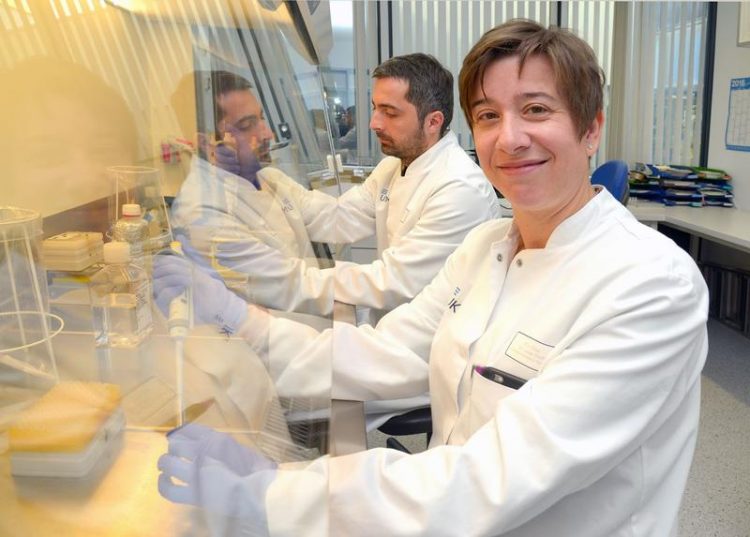New hypothesis on the origins of centres of inflammation in multiple sclerosis

Dr. Luise Klotz at work in the laboratory Photo: FZ
The scenario resembles a serious motor accident: a car has spun out of control, breaches the central crash barrier and collides with the oncoming traffic. In the case of multiple sclerosis, harmful T-cells break through the protective blood-brain barrier and thus penetrate into the central nervous system (CNS), where they trigger a destructive inflammation.
What’s special about this is that evidently the CNS also has “accident black spots” – in other words, places where an especially high number of centres of inflammation are be found. Neuro-immunologists at Münster University have now found out why this is so.
“The decisive factor is the interplay between the immune cells and the endothelium – a protective covering which is usually particularly non-permeable, demarcates our blood vessels and is also found at the blood-brain barrier,” explains Dr. Luisa Klotz, a lecturer, research team leader and senior physician at the Department of General Neurology at Münster University Hospital.
In the case of multiple sclerosis the destructive immune cells have found a way to attack the endothelium directly and thus contribute to causing damage (lesions) in the brain. What was hitherto unclear was why certain regions are affected more often in the process while others remain protected.
Observations carried out on mice pointed out the way to a solution for Klotz and her team. The diseased animals originally had centres of inflammation only at places typical of MS lesions. After the researchers had switched off the inhibiting molecule B7H1 – which helps to keep the immune system in balance – the state of the disease in the animals deteriorated. Centres of inflammation were now to be found in other areas of the brain not normally affected.
These new centres arose because the immune cells in this model triggered greater damage to the endothelial protective covering. As a result, the way was open to new areas of the brain. “Such an impairment of the endothelium’s function is a necessary – if not perhaps the only – condition for inflammatory lesions to arise. The underlying mechanisms of this impairment had not been known up to this point,” says Prof. Heinz Wiendl, Director of the General Neurological Clinic.
With their discovery the neuro-immunologists have also proved for the first time why even punctual changes in certain immune-regulatory molecules – as in the case of B7H1 here – can accelerate or slow down the destructive effect of the immune cells to such an extent. To return to the car metaphor: the speed limit on roads is just like the work on B7H1 for the Münster neuro-immunologists. “We have to use the properties of proteins such as this one to reduce the damage which the cells do in the nervous system,” is how doctoral student Ivan Kuzmanov explains the promising approach which he and his colleagues have adopted in the research they are currently engaged on. At the same time, however, he warns against any premature hopes: “We’re still a long way from here to producing medicine to treat MS,” he says.
Media contact:
Dr. Thomas Bauer
Referent Research and Teaching at Münster University Medical Faculty
phone: 0251-83-58937
mobile: 0171-4948979
email: thbauer@uni-muenster.de
Original publication:
Klotz L. et al.: B7-H1 shapes T-cell-mediated brain endothelial cell dysfunction and regional encephalitogenicity in spontaneous CNS autoimmunity. Proc Natl Acad Sci U S A. 2016 Oct 11;113(41):E6182-E6191. Epub 2016 Sep 26. DOI: doi: 10.1073/pnas.1601350113
http://www.pnas.org/content/113/41/E6182 PNAS/Originalpublikation
Media Contact
More Information:
http://www.uni-muenster.de/All latest news from the category: Life Sciences and Chemistry
Articles and reports from the Life Sciences and chemistry area deal with applied and basic research into modern biology, chemistry and human medicine.
Valuable information can be found on a range of life sciences fields including bacteriology, biochemistry, bionics, bioinformatics, biophysics, biotechnology, genetics, geobotany, human biology, marine biology, microbiology, molecular biology, cellular biology, zoology, bioinorganic chemistry, microchemistry and environmental chemistry.
Newest articles

A ‘language’ for ML models to predict nanopore properties
A large number of 2D materials like graphene can have nanopores – small holes formed by missing atoms through which foreign substances can pass. The properties of these nanopores dictate many…

Clinically validated, wearable ultrasound patch
… for continuous blood pressure monitoring. A team of researchers at the University of California San Diego has developed a new and improved wearable ultrasound patch for continuous and noninvasive…

A new puzzle piece for string theory research
Dr. Ksenia Fedosova from the Cluster of Excellence Mathematics Münster, along with an international research team, has proven a conjecture in string theory that physicists had proposed regarding certain equations….



